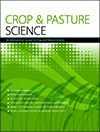Grain sorghum is a food source for people in semi-arid regions; however, its productivity is compromised by its inefficient leaf architecture. Aiming to improve sorghum productivity, the research focused on evaluation of leaf architectural traits and identification of ideotypes with outstanding leaf architecture. Through multi-environment trials, an ideal genotype was selected for best leaf architecture performance, which will be useful as the parental line to optimise sorghum leaf architecture in a breeding program.

Crop & Pasture Science
Volume 75 Number 4 2024
Soil salinity adversely affects plant growth and causes considerable losses in cereal crops. In this study, genetic variation in salinity tolerance was evaluated in sea barley (Hordeum marinum ssp. marinum). Based on plant growth-related traits, mineral nutrition and salt stress indices, lines with high yield under stress and non-stress conditions, or showing a small yield loss under salinity constraints, were identified. These lines will be useful for future breeding programs towards salinity tolerance in cereal crops.
Finding new genotypes resistant to Fusarium infection represents an important goal for the improvement of maize cultivation. In this regard, a collection of maize landraces deriving from Emilia-Romagna (Italy) region was studied. These landraces represent starting resources crucial for broadening the genetic bases of maize and introducing new resistant alleles useful in breeding programs targeting multiple pathogens and their associated mycotoxins.
CP23333Forage brassicas can enhance the feed base and mitigate feed gaps across diverse environments
Long-term simulation modelling showed that autumn-sown forage brassicas can serve as a reliable and valuable forage source in drier environments across Australia’s crop–livestock zone. They have a long grazing window and stable production across a range of sowing dates and environments. Integrating forage brassicas into the existing feed base can reduce the frequency and magnitude of on-farm feed deficits in livestock production systems. They can also allow for a safe increase in stocking rates and reduce the need for supplementary feed.
CP23333 Abstract | CP23333 Full Text | CP23333PDF (2.9 MB) Open Access Article
Wheat grown on soils contaminated by arsenic (As) may accumulate toxic levels of As in grains, allowing As to enter the human food chain. The study evaluated the effect of soil zinc (Zn) application on grain As and grain accumulation of Zn in two Zn-biofortified wheat cultivars grown on As-contaminated soil. Soil Zn application decreased grain As accumulation to below the permissible limit of 0.15 mg As kg−1 and simultaneously increased grain Zn accumulation.




